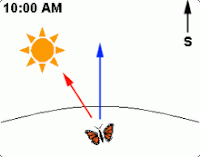 |
| Monarch Butterfly |
They can travel between 50 to 100 miles a day during their 3000 mile journey to Oyamel fir forests in the Mexican mountains nearly two miles above sea level.
They roost in the trees in a dozen or so of these mountain areas from October to March, often returning to the same tree in which their ancestor roosted the previous year.
In late summer in northeastern North America dwindling food supply and shorter days trigger the Monarch's migratory impulse. A generation that has hatched after mid-August begins the trek south for wintering grounds they've never been to before. Most summering Monarchs live for about two to six weeks, but this migrating generation can live up to nine months.
The migrants travel during the day and roost at night, often in the same trees that previous generations used as roost sites during their migration.
During the summer their range covers close to 400,000 square miles, but when they finally arrive in Mexico they squeeze into territories of less than half a square mile.
 |
| Monarch's roosting in Mexican Oyamel fir trees |
Their internal clock tells them the time of day. In the morning when the sun is rising they navigate to the west of it. At noon they fly toward it and in the afternoon they fly to the east of it. This strategy keeps them flying due south as depicted in these figures:
Another amazing fact is that the generation that made the long trip from the northeast and over-wintered in Mexico is not the generation that returns to the northeast. This generation begins the trip back in the spring but they reproduce and die along the way.
The second generation continues the migration, but they, too, reproduce and die along the way. It's the third generation that makes it back to the summering grounds in the northeast, but they also reproduce and die, so it is their offspring that begin the cycle all over again in August.
There's an interactive feature here that shows the Monarch's pattern of migration. All of this raises questions:
How does each year's crop of butterflies "know" the route to take to get back to the same trees in Mexico that their ancestors left from when they've never done it before?
How do those butterflies born along the return trip "know" to continue the migratory flight and "know" which direction to take?
What is the source of the information needed for these insects to complete this astonishing journey?
And how would all this have come about through a blind, purposeless process like natural selection and genetic mutation?
Comparisons of migratory monarch genomes with the genomes of non-migratory monarchs has revealed that some five hundred and thirty genes are involved in migratory behavior so that means that in the history of the species there must have been a minimum of five hundred thirty genetic mutations, all of which were random but which fortuitously produced the ability to successfully make this migration.
Moreover, Monarchs are believed to have evolved about two million years ago so the migrating variety must've split off from the ancestral stock sometime thereafter. Thus, at the most, those 535 mutations must've accumulated within the last two million years, a very short time for all that evolution to have taken place - at least it's a very short time if the evolution were unguided by any outside intelligence.
If this all came about naturalistically that would be almost miraculous, which is ironic since naturalism discounts miracles.
It's possible, of course, that this migratory behavior could've evolved by unguided, purposeless processes, in the same sense that it's possible that elephants could've evolved the ability to fly, but it takes a king-sized portion of blind faith to dogmatically insist that it did.


